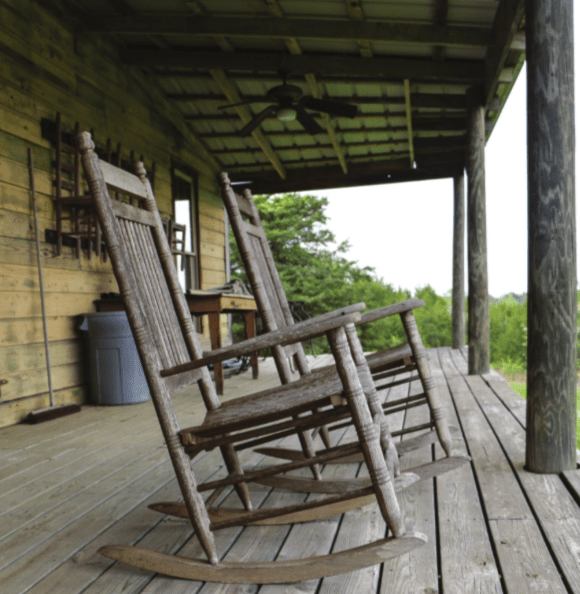 The Chickasaws plan to build a heritage center in Tupelo as part of a quest to reconnect with their homeland.
The Chickasaws plan to build a heritage center in Tupelo as part of a quest to reconnect with their homeland.
A white bus with “The Chickasaw Nation” printed in purple on one side scoots through a Tupelo neighborhood and pulls up next to Pierce Street Elementary school.
This is where the Chickasaws fought the French Army in the 1736 Battle of Ackia, and this bus is filled with nine supervisors and managers of the Chickasaw Nation’s Department of Culture and Humanities, craning their heads to look down a ridge and imagine what it must have looked like when French soldiers and Choctaws massed to attack.
Once a Chickasaw village, Ackia became the place where the tribe would ultimately change the course of American history by defeating French Governor Jean-Baptiste Le Moyne, Sieur de Bienville and his army, thwarting French plans to destroy the Chickasaw and limit British influence in the region. Today, a historical marker with details of the battle is the only sign of the climactic struggle that took place here almost 300 years ago.
“One thing you have to do when you’re in the Homeland is kind of use your imagination,” William Brekeen, a cultural interpreter for the tribe, warned as the tour began.
After all, a city of nearly 40,000 people was built on this land, and it has been almost 200 years since the mighty Chickasaw Nation called it home.
Yet, Tupelo is littered with artifacts, burial sites, and ridges once occupied by Chickasaws past. It is the epicenter of the tribe’s Homeland, which stretches through the Blackland Prairie in Mississippi and parts of Alabama, Tennessee and Kentucky.
To the Chickasaw, this is sacred ground.
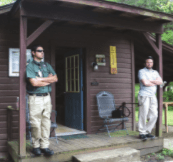
Oklahoma, and Brian Hatton fell in love with the flora
and fauna of North Mississippi.
This is why the Chickasaw Nation selected Tupelo as the perfect spot for the Smithsonian-quality heritage center they plan to build near the Natchez Trace to trumpet their culture and history. It is why the tribe buses its people here, 500 miles from Oklahoma, to reconnect with their past. And it is why the tribe has staffed a special homeland affairs office here.
In a very real sense, the Chickasaw are back, and they are here to stay.
“A lot of Chickasaw tribal history and identity was forged here in the homelands,” said Brad Lieb, the Mississippi-based Tribal Archaeologist for the Chickasaw Nation’s Department of Homeland Affairs.
“Governor (Bill) Anoatubby knows the importance of keeping in touch with Chickasaw heritage and to maintaining that living connection with the traditional homeland for Chickasaw people. He is creating opportunities for Chickasaw people to travel that long, 500-mile distance back from Oklahoma to North Mississippi, and Tupelo specifically, to reconnect with their ancestral heritage,”
Lieb said.
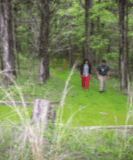
The heritage center will become an additional resource for tribal members to reconnect through. Meanwhile, the bus tours – taking Chickasaws throughout Tupelo, Amory, Lee County, Pontotoc County, and more – will have to do.
The tour bus rolled by many sites important to Chickasaw heritage, including the remains of a Chickasaw village site on the Natchez Trace Parkway, the Chissa’Talla’ Preserve – a nature and cultural preserve on the Coonewah ridge – Tishomingo’s home site, and Moundville, Alabama.
The group made a melancholy last stop in Memphis for one last look at the picturesque Chickasaw bluffs then drove on, back to Oklahoma.
Midway through the first day of the tour, the bus rolled down a wooded road with old, decrepit houses, some of which looked as if they were about to fall in on themselves. Past a vast grassy meadow littered with trees, a large, gray, two-story cabin sat on a hilltop overlooking the Coonewah Creek Valley below.
The nine tribal employees made their way out of the bus and to the other side of the cabin, which looked down onto farmland. They stood surrounded by wildflowers dancing in the breeze, mesmerized at the natural beauty and wealth of exploration opportunities before them. It wasn’t long until they began exploring, peeking into the windows of the cabin and examining some rubble nearby.
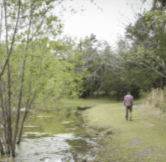
This site was picked over extensively by collectors of Chickasaw relics throughout the 1970s and ‘80s. Eventually, most of one man’s collection made it back to the Chickasaw Nation for preservation. Now, they’ve purchased the land, once a Chickasaw village.
It is impossible to overestimate the power of the homelands to the tribe, seeing and touching it, becoming part of its history, after only hearing tales of it.
To many, the homelands bring an inner peace. For others, seeing the cast aside or obscure nature of some of the most important Chickasaw heritage sites brings back the pain of the Indian Removal Act of 1830, which led to the Trail of Tears and the establishment of the Chickasaw Nation in Oklahoma.
For example, the ancient grave of Piominko, one of the Chickasaws’ most important leaders, is believed to lie beneath a rental house in a Tupelo neighborhood. The site of Ogoula Tchetoka, the first battle against the French, sprawls atop a grassy ridge next to a customer service center off Interstate 22. At the Long Town settlement area, 20 Chickasaw people are reburied near where they lay for centuries until disturbed by hospital construction. In a hidden glade, an impressive stone monument marks the spot in a space between trees. Fifteen yards away is a busy street.
“People ride by this every day and don’t realize the history here,” Brekeen said.
“It’s just sad. Sad we had to leave. We lost so much land here,” said Dixie Brewer, performing arts manager and member of the Chickasaw dance troupe. This was not Brewer’s first time to the homelands. She has danced at a number of sites throughout the area.
The connection to the homelands runs deep for David Correll, greenhouse supervisor for the tribe’s department of history and culture in Oklahoma. After his first visit two years ago, he fell in love with the flora and fauna of North Mississippi.
As he walked through the Chissa’Talla’ site at Coonewah Ridge, Correll kept his eyes peeled for interesting plants.
“Hey what’s this?” he said to Brekeen.
“American Columbo. They used to call it Indian Lettuce. Very astringent.”
Correll immediately plunged into the brush to photograph it.
In fact, at almost every site, medicinal plants could be found. From the multi-use Self Heal, to Echinacea, and purple, spiny thistles. While many people consider some of these plants invasive weeds, the Chickasaw had a purpose for each.
After leaving the preserve, Correll planned to return and bag up several plants to take to his greenhouse. In exchange, he will bring some native plants he’s been cultivating in Oklahoma to leave in their place.
Oklahoma, while it is the home for the Chickasaw nation, lacks something, Correll said. “I feel like it’s home but something is missing. Here, it feels normal… The land is like a pharmacy, like our hospital,” he said.
Correll’s first visit two years ago left him with a vivid vision of what life would have been like for his ancestors on the fertile land near the Coonewah Ridge.
“It was sleeting and ice was sticking to my clothes,” Correll said. “I was sitting down there in the sleet and I could suddenly see our people in the flat fields below the village. The water from the rivers was coming up and covering the fields but our gardens were green and flourishing on the mounds. Our Three Sisters gardens were there… I could see our history come to life. I could see our village full of our people… It felt like home.”
The Chickasaw Nation pre-removal was centered in Tupelo, according to Lieb, so much so that French maps from the 1700s accurately depict how the tribe’s villages consolidated in Tupelo for self-protection.
Archaeological and historical studies since the 1930s have compiled compelling evidence that the city was the site of many Chickasaw towns, battles, and important interactions.

“The Chickasaw people have stories and oral tradition about all this, but being removed for 180 years to Indian Territory in Oklahoma, everybody has forgotten where some of these actual places were,” Lieb said. “It was up to archaeology to relocate the exact sites, and that’s an ongoing process, but it’s more than half done. That’s why we’re confident about setting up the Chickasaw Heritage Center at Tupelo, establishing other preserves, and commemorating village sites as well.”
The heritage center will be a hub not only for visiting Chickasaws but also for other people interested in learning about the Native American experience.
Tupelo attorney Brad Prewitt is an executive officer for the tribe and director of the Inkana Foundation, which is working to establish a stronger connection to the area. A large chunk of Chickasaw history and culture has its origins in the homeland, and Prewitt said even the Chickasaw language derives its contextual meaning from the distinctive southeastern natural environment which the tribe once called home. The heritage center will seek to explain the nexus between the cultural, the historical, and the natural.
“Chickasaw Nation Governor Anoatubby is very energized about this, and obviously, we’re energized about it, too, as this represents an historic opportunity for the tribe to officially come home in a substantial, exceptionally transformative way,” Prewitt said.
Much like the Chickasaw Nation’s elaborate cultural center in Oklahoma, the heritage center will be a multimodal, active facility with opportunities to experience Chickasaw culture and arts. The site will include interpretations of how life would have been in the homeland. There are plans to restore the land nearby to a prairie-like state, just as the Chickasaws would have burned off the grass around their villages for protection. Nature trails will surround the area,allowing visitors to immerse themselves in the ecology of the Chickasaw ancestral lands.
“With partnerships underpinning our foundation efforts, at the center we’ll explore that theme even historically, by telling a story not only of the Chickasaw people, but connecting them to the greater Southeastern Indian experience through time and place. The center will add meaning to all of it,” Prewitt said.
After its construction within about five years, according to Prewitt, the heritage center will be a unique addition to existing attractions such as the Natchez Trace Parkway and the Mississippi Mound Trail.
“I think that Chickasaw Nation’s reverence for this place marries well with Mississippi’s affection for our roots and our awareness of being a people on an ever-moving historical
and cultural journey,” Prewitt said. “I think that there’s a common language of love for the place that can be shared by both people.”
Tupelo has already embraced one of America’s greatest allies within the Chickasaw tribe: Piominko. He is immortalized in statue form in Tupelo’s Fair Park in front of City Hall, or as Mayor Jason Shelton calls it, “Tupelo’s front porch,” just a stone’s throw from a statue of another American legend – Elvis Presley.
Piominko was the Chickasaw equivalent to George Washington. In fact, they were great friends. Washington even bestowed a presidential peace medal on Piominko. His likeness, sculpted by renowned Mississippi artist William “Bill” Beckwith of Taylor, stands stoic in bronze, carrying a long rifle, the peace medal dangling from his neck. He is wearing a Washington-style coat, which would have been blue with gold buttons.
When the tour bus stopped at the rental house where Piominko’s grave is believed to lie, Correll’s eyes grew wide. “We need to buy it,” he said. “It’s important.”
Shelton said Tupelo’s relationship with the Chickasaws is beneficial to both tribe and town, as their history and culture is synonymous with Tupelo’s history.
“This is the native homeland of the Chickasaw Nation and that history is not lost upon us,” Shelton said. “We want to work with them in any way possible to develop that relationship and tell the story of this area. It [the Chickasaw Heritage Center] will have a very significant historical, cultural, economic, and tourism related impact on our area.”
Joe Thomas, who drove the tour bus, said the homeland experience is much like reliving what it means to be a Chickasaw.
“I feel like I’m time traveling each time I come back home,” he said while examining arrow points in a museum inside the Pontotoc post office.
The town of Pontotoc owes its very existence to the Chickasaw because that’s where the land office was set up to handle white settlers’ purchase of Chickasaw lands after the tribe’s removal to Oklahoma.
Moments before, as the bus approached its late afternoon stop there, Thomas took the bus into a parking lot from the wrong direction.
“You’re going the wrong way!” someone yelled, good-naturedly.
“Tourist!” another added.
“No,” Thomas said, smiling softly. “We’re home.”
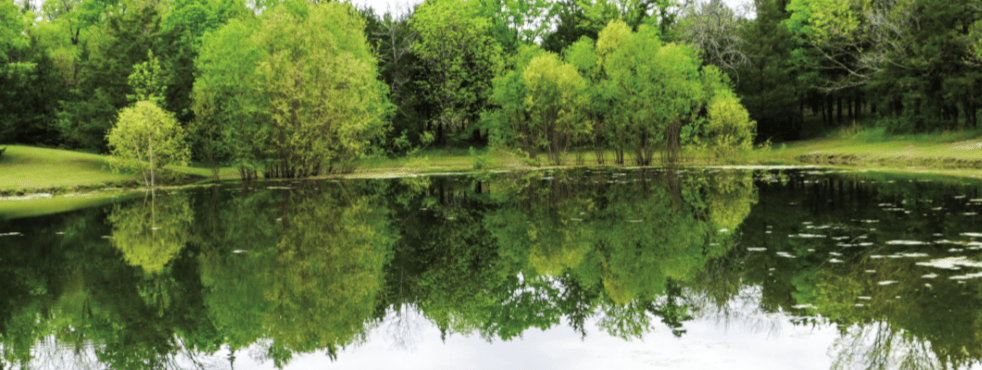
By Zoe McDonald. Photography by Ariel Cobbert.

THIRD ROW: Bill Rose, Chi Kalu, Slade Rand, Mitchell Dowden, Will Crockett. Not pictured: Tori Hosey PHOTO BY THOMAS GRANING
The Meek School faculty and students published “Unconquered and Unconquerable” online on August 19, 2016, to tell stories of the people and culture of the Chickasaw. The publication is the result of Bill Rose’s depth reporting class taught in the spring. Emily Bowen-Moore, Instructor of Media Design, designed the magazine.
“The reason we did this was because we discovered that many of them had no clue about the rich Indian history of Mississippi,” said Rose. “It was an eye-opening experience for the students. They found out a lot of stuff that Mississippians will be surprised about.”
Print copies will be available October 2016.
For questions or comments, email us at hottytoddynews@gmail.com.
Follow HottyToddy.com on Instagram, Twitter and Snapchat @hottytoddynews. Like its Facebook page: If You Love Oxford and Ole Miss…
Recent Comments